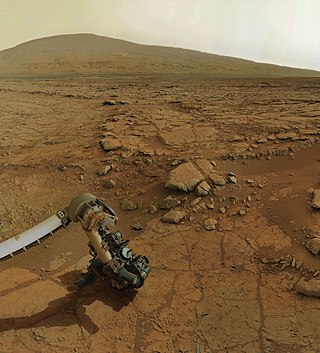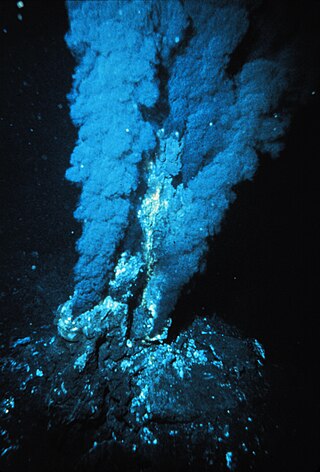
Astrobiology is a scientific field within the life and environmental sciences that studies the origins, early evolution, distribution, and future of life in the universe by investigating its deterministic conditions and contingent events. As a discipline, astrobiology is founded on the premise that life may exist beyond Earth.

An endolith or endolithic is an organism that is able to acquire the necessary resources for growth in the inner part of a rock, mineral, coral, animal shells, or in the pores between mineral grains of a rock. Many are extremophiles, living in places long considered inhospitable to life. The distribution, biomass, and diversity of endolith microorganisms are determined by the physical and chemical properties of the rock substrate, including the mineral composition, permeability, the presence of organic compounds, the structure and distribution of pores, water retention capacity, and the pH. Normally, the endoliths colonize the areas within lithic substrates to withstand intense solar radiation, temperature fluctuations, wind, and desiccation. They are of particular interest to astrobiologists, who theorize that endolithic environments on Mars and other planets constitute potential refugia for extraterrestrial microbial communities.

The Nomad rover is an uncrewed vehicle designed as a test for such a vehicle to ride on other planets.

The possibility of life on Mars is a subject of interest in astrobiology due to the planet's proximity and similarities to Earth. To date, no proof of past or present life has been found on Mars. Cumulative evidence suggests that during the ancient Noachian time period, the surface environment of Mars had liquid water and may have been habitable for microorganisms, but habitable conditions do not necessarily indicate life.

The Astrobiology Field Laboratory (AFL) was a proposed NASA rover that would have conducted a search for life on Mars. This proposed mission, which was not funded, would have landed a rover on Mars in 2016 and explore a site for habitat. Examples of such sites are an active or extinct hydrothermal deposit, a dry lake or a specific polar site.

The Atacama Desert is a desert plateau located on the Pacific coast of South America, in the north of Chile. Stretching over a 1,600 km (990 mi) strip of land west of the Andes Mountains, it covers an area of 105,000 km2 (41,000 sq mi), which increases to 128,000 km2 (49,000 sq mi) if the barren lower slopes of the Andes are included.
Almost Human: Making Robots Think is a book written by Lee Gutkind founder of Creative Nonfiction. Gutkind spent six years as a "fly on the wall" researcher at the Robotics Institute at Carnegie-Mellon University in Pittsburgh. He observed scientists and students working to design, build, and test robots so advanced that they will one day be able to work alongside or, in some cases, even replace humans. Almost Human is an intense portrait of the robotic subculture and the challenging quest for robot autonomy. Almost Human is 330 pages long and is published by W.W. Norton. In May 2007 Gutkind appeared as a guest author on The Daily Show with Jon Stewart to talk about robots, the future, and his book.

Astrobiology Science and Technology for Exploring Planets (ASTEP) was a program established by NASA to sponsor research projects that advance the technology and techniques used in planetary exploration. The objective was to enable the study of astrobiology and to aid the planning of extraterrestrial exploration missions while prioritizing science, technology, and field campaigns.
Penelope J. Boston is a speleologist. She was associate director of the National Cave and Karst Research Institute in Carlsbad, New Mexico, along with founding and directing the Cave and Karst Studies Program at New Mexico Institute of Mining and Technology in Socorro. Among her research interests are geomicrobiology of caves and mines, extraterrestrial speleogenesis, and space exploration and astrobiology generally.
Interplanetary contamination refers to biological contamination of a planetary body by a space probe or spacecraft, either deliberate or unintentional.
Rosalind Franklin, previously known as the ExoMars rover, is a planned robotic Mars rover, part of the international ExoMars programme led by the European Space Agency and the Russian Roscosmos State Corporation. The mission was scheduled to launch in July 2020, but was postponed to 2022. The 2022 Russian invasion of Ukraine has caused an indefinite delay of the programme, as the member states of the ESA voted to suspend the joint mission with Russia; in July 2022, ESA terminated its cooperation on the project with Russia. As of May 2022, the launch of the rover is not expected to occur before 2028 due to the need for a new non-Russian landing platform.
Terrestrial analogue sites are places on Earth with assumed past or present geological, environmental or biological conditions of a celestial body such as the Moon or Mars. Analogue sites are used in the frame of space exploration to either study geological or biological processes observed on other planets, or to prepare astronauts for surface extra-vehicular activity.
MELOS is a Japanese rover mission concept under study for an engineering demonstration of precision landing, and to look for possible biosignatures on Mars using a rover. JAXA has not published updates since 2015.

Icebreaker Life is a Mars lander mission concept proposed to NASA's Discovery Program. The mission involves a stationary lander that would be a near copy of the successful 2008 Phoenix and InSight spacecraft, but would carry an astrobiology scientific payload, including a drill to sample ice-cemented ground in the northern plains to conduct a search for biosignatures of current or past life on Mars.
ExoLance is a low-cost mission concept that could hitch a ride on other missions to Mars in an effort to look for evidence of subsurface life.

Nathalie A. Cabrol is a French American astrobiologist specializing in planetary science. Cabrol studies ancient lakes on Mars, and undertakes high-altitude scientific expeditions in the Central Andes of Chile as the principal investigator of the "High Lakes Project" funded by the NASA Astrobiology Institute (NAI). There, with her team, she documents life's adaptation to extreme environments, the effect of rapid climate change on lake ecosystems and habitats, its geobiological signatures, and relevance to planetary exploration.
Exposing Microorganisms in the Stratosphere (E-MIST) is a NASA study to determine if a specific microorganism could survive conditions like those on the planet Mars. The study transported Bacillus pumilus bacteria and their spores by helium-filled balloon to the stratosphere of Earth and monitored the ability of the microorganisms to survive in extreme Martian-like conditions such as low pressure, dryness, cold, and ionizing radiation.
Mars habitability analogue environments on Earth are environments that share potentially relevant astrobiological conditions with Mars. These include sites that are analogues of potential subsurface habitats, and deep subsurface habitats.
Signs Of LIfe Detector (SOLID) is an analytical instrument under development to detect extraterrestrial life in the form of organic biosignatures obtained from a core drill during planetary exploration.

Vandana "Vandi" Verma is a space roboticist and chief engineer at NASA's Jet Propulsion Laboratory, known for driving the Mars rovers, notably Curiosity and Perseverance, using software including PLEXIL programming technology that she co-wrote and developed.








